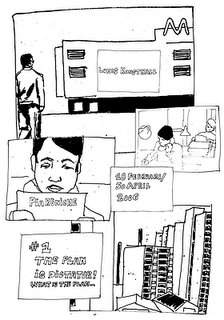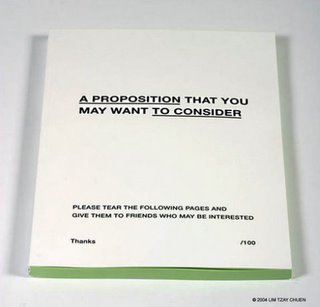 Self-portrait nursing 2004
Self-portrait nursing 2004
Monday, February 27, 2006
Wednesday, February 22, 2006
Architecture and Design Blogs
From Artkrush
Architects and designers are notorious for their eccentrically stylish accessories — from eyeglasses to briefcases to toilets — and their blogs are no exception. Sleek, minimal, and intelligent, these architecture and design blogs are the new source for up-to-the-minute commentary on emerging talent, broad trends, and nifty new products.Reference sites such as Archinect offer one-stop shopping for news, reviews, job postings, and discussion groups, while personal architecture blogs provide more specialized information. They range from the dead serious to the impudent. In the former category is Progressive Reactionary, which melds political and architectural criticism, and Kazys Varnelis' site, which probes the intersection of architecture and network society. BLDGBLOG also offers lengthy analysis of trends in architecture, as well as reviews of art and film. At the other extreme, Archibot runs a "Hot or Not" contest for buildings, allowing you to rate canonical and amateur designs just like you rate desperate college kids.These cyber critics are global travelers, and their efforts connect the architectural communities of the East and West. Brett Steele, the director of the famously experimental Architectural Association School in London, posts his curriculum and photos of student work on the site Resarch. Chicago architect John Hill runs Archidose, a series of sardonic postings on international architecture and Midwestern oddities, and Eizo Okada uploads photos of buildings all over the world onto his Japanese site, dezain.net. The site fabprefab follows the rise of affordable, modernist prefab houses around the world, and the Center for Land Use Interpretation documents the shifting contemporary landscape.
Product-design aficionados are buying up web real estate even faster than their architectural counterparts, generating hundreds of blogs devoted to furniture, interiors, lighting, and gizmos. These sites are dangerous territory for anyone who covets over-designed coffee tables and throw pillows. Designboom and Design Addict offer extensive news, images, interviews, and links, while personal blogs unearth the quirkier inventions (a PC computer in a whiskey bottle?). MoCo Loco, Reluct, and Sensory Impact all select the most alluring products and offer commentary on global design trends. Core 77 finds more bizarre objects, and idgrid highlights the best of industrial design. Perhaps the most useful sites are design*sponge and Apartment Therapy, which showcase affordable home products and solutions for tiny apartments.And for those of us who just can't shake our loyalties to certain print publications, Domus, Frame, Icon, and Dwell have lively websites with online forums and full-text articles from back issues.
Architects and designers are notorious for their eccentrically stylish accessories — from eyeglasses to briefcases to toilets — and their blogs are no exception. Sleek, minimal, and intelligent, these architecture and design blogs are the new source for up-to-the-minute commentary on emerging talent, broad trends, and nifty new products.Reference sites such as Archinect offer one-stop shopping for news, reviews, job postings, and discussion groups, while personal architecture blogs provide more specialized information. They range from the dead serious to the impudent. In the former category is Progressive Reactionary, which melds political and architectural criticism, and Kazys Varnelis' site, which probes the intersection of architecture and network society. BLDGBLOG also offers lengthy analysis of trends in architecture, as well as reviews of art and film. At the other extreme, Archibot runs a "Hot or Not" contest for buildings, allowing you to rate canonical and amateur designs just like you rate desperate college kids.These cyber critics are global travelers, and their efforts connect the architectural communities of the East and West. Brett Steele, the director of the famously experimental Architectural Association School in London, posts his curriculum and photos of student work on the site Resarch. Chicago architect John Hill runs Archidose, a series of sardonic postings on international architecture and Midwestern oddities, and Eizo Okada uploads photos of buildings all over the world onto his Japanese site, dezain.net. The site fabprefab follows the rise of affordable, modernist prefab houses around the world, and the Center for Land Use Interpretation documents the shifting contemporary landscape.
Product-design aficionados are buying up web real estate even faster than their architectural counterparts, generating hundreds of blogs devoted to furniture, interiors, lighting, and gizmos. These sites are dangerous territory for anyone who covets over-designed coffee tables and throw pillows. Designboom and Design Addict offer extensive news, images, interviews, and links, while personal blogs unearth the quirkier inventions (a PC computer in a whiskey bottle?). MoCo Loco, Reluct, and Sensory Impact all select the most alluring products and offer commentary on global design trends. Core 77 finds more bizarre objects, and idgrid highlights the best of industrial design. Perhaps the most useful sites are design*sponge and Apartment Therapy, which showcase affordable home products and solutions for tiny apartments.And for those of us who just can't shake our loyalties to certain print publications, Domus, Frame, Icon, and Dwell have lively websites with online forums and full-text articles from back issues.
Tuesday, February 21, 2006
Thursday, February 16, 2006
Monday, February 13, 2006
Notes for an Art School
Notes for an Art School, the first publication of Manifesta 6 School Books, was commissioned by the International Foundation Manifesta in Amsterdam and Manifesta 6 in Nicosia. It is an anthology of essays and interviews by international artists, curators, theorists and educators on the topic of art education. Contributors are Mai Abu ElDahab, Babak Afrassiabi, Julie Ault, Martin Beck, Liam Gillick, Boris Groys, Olaf Metzel, Haris Pellapaisiotis, Tobias Rehberger, Walid Sadek, Nasrin Tabatabai, Jan Verwoert, Anton Vidokle and Florian Waldvogel.The book lays the theoretical ground for Manifesta 6, the European Biennial of Contemporary Art, for which the curators Mai Abu ElDahab, Anton Vidokle and Florian Waldvogel propose to challenge the conventional format of the large-scale exhibition and, alternatively, set up an art school - the Manifesta 6 School - in Nicosia, from 23 September to 17 December 2006.The contributors to the book rethink the goals and structure of an art school, its ideological contexts, the positioning of its students to the art world, its relationship to social and political conditions, and the level of its discursive involvement, drawing on specific examples and on their own experiences to interrogate the appropriateness and validity of existing school models.In their collaborative essay, Julie Ault and Martin Beck speak about the democratization of academies as a means of generating active social engagement. Boris Groys conjectures that ‘the goal of education is to make the students able to read an apology as a critique’, Liam Gillick addresses ‘the rift between the theoretical components of an art school environment and other practical working aspects of the same place’, and Jan Verwoert tackles the academy as a site of production from the viewpoint of both its defender and critic. Olaf Metzel looks at some possibilities of reaction outside of institutional frameworks, Walid Sadek argues that by positioning itself as an institution in constant flux, the art academy can become a safe haven supporting the proliferation of multiple significations, and Babak Afrassiabi and Nasrin Tabatabai, dissecting the example of Abbas Kiarostami’s film First Case, Second Case, call for knowledge production based on an understanding of the changing nature of discourse. Haris Pellapaisiotis writes about Artalk, a lecture series he organises in Nicosia in absence of alternative institutional frameworks for critical cultural dialogue, while Tobias Rehberger discusses his teaching method as a process of destroying the clichés and preconceived notions that students bring with them into art school, and also provides some personal insight into his own education.Each of the Curators of Manifesta 6 also contributes an essay addressing the issues facing the Manifesta 6 School from different standpoints: Mai Abu ElDahab considers the way in which the School can assert its socio-political role; Anton Vidokle looks at the Manifesta 6 School a project in dialogue with the history of experimental art education, and Florian Waldvogel proposes the School as an alternative model in contrast to the existing European academies.
Notes for an Art School is designed and typeset by Dexter/Sinister, Nicosia, and distributed internationally by IDEA Books: http://www.ideabooks.nl It can be ordered through http://www.manifesta6.org.cy and http://www.manifesta.org A digital version of the book’s essays can be found on the Manifesta 6 website: http://www.manifesta6.org.cy An online forum on the topics of the book will soon launch alongside the essays.
Notes for an Art School is designed and typeset by Dexter/Sinister, Nicosia, and distributed internationally by IDEA Books: http://www.ideabooks.nl It can be ordered through http://www.manifesta6.org.cy and http://www.manifesta.org A digital version of the book’s essays can be found on the Manifesta 6 website: http://www.manifesta6.org.cy An online forum on the topics of the book will soon launch alongside the essays.
Pia Ronicke

Pia Rönicke is concerned with urban realities and fantasies. She continuously investigates how we as ‘users’ can influence (and are influenced by) what urban planners, architects and designers do. She has studied 20th century utopianism, how it looks ‘on paper’ and ‘in reality’. The exhibition traces the development of Pia Rönicke’s practice through various modes of narration. She has worked with purely visual formats like computer-aided animation, and she has staged situations and documented them in images and text. Increasingly, she also scripts, directs and produces films.
Pia Rönicke’s new film Zonen (‘The Zone’, 2005) is premiered at Lund Konsthall. It shows three young Danish architects (Tue Hasselberg-Foged, Kristoffer Lindhardt Weiss and Sinus Lynge) on a visit to a site they have proposed to transform into a town for 20,000 people. The film is based on their theoretical jargon, and becomes a commentary on the relation between ideas and their realisation. Some infrastructure is already in place in the Zone, but it is strangely suspended between the real and the fictional, the past and the future.In her practice, Pia Rönicke interprets what is going on in contemporary society from her specific point of view. Who benefits from the grand utopian visions of societal development? Can we influence the changes our surroundings are undergoing? How will the future look? Can we see glimpses of it in an artist’s vision? Welcome to Lund Konsthall to see how Pia Rönicke tackles these issues.
Pia Rönicke (b 1974) lives and works in Copenhagen. After graduating from the Royal Danish Art Academy in Copenhagen and California Institute of the Arts in Los Angeles she has worked in the Nordic region and internationally. She has exhibited at Moderna Museet in Stockholm (2001), Tate Modern (2005), the Nordic biennial Momentum 2 in Moss, Norway (2000) and the European biennial Manifesta 4 in Frankfurt (2002).
Fresh Talk/Daring Gazes: Conversations on Asian American Art

Elaine H. Kim, Margo Machida, Sharon Mizota, Lisa Lowe
Fresh Talk/Daring Gazes chronicles the blossoming of Asian American art and anticipates the growing democratization of American art and culture. Pairing work by twenty-four contemporary Asian American visual artists with responses provocatively drawn from cultural critics, other artists, activists, and intellectuals, this book explores themes of geographical movement, the sexuality of Asian bodies, colonization, miscegenation, hybrid forms of immigrant cultures, the loss of home, war, history, and memory.
Elaine H. Kim's historical introduction charts the trajectory of Asian American art from the nineteenth century to the present, offering a comprehensive account of artists, major artworks, and major events. Commentaries by writers, artists, and cultural activists examine the work of visual artists such as Pacita Abad, Albert Chong, Y. David Chung, Allan deSouza, Michael Joo, Hung Liu, Yong Soon Min, Manuel Ocampo, PipoNguyen-Duy, Roger Shimomura, Carlos Villa, and Martin Wong. Prominent artists and critics such as Homi K. Bhabha, Luis Camnitzer, Enrique Chagoya, Gina Dent, Ellen Gallagher, Arturo Lindsay, Kobena Mercer, Griselda Pollock, Jolene Rickard, Faith Ringgold, Ella Shohat, Lowery Stokes Sims, Jaune Quick-to-See Smith, and Hulleah Tsinhnahjinnie offer thought-provoking reflections on each artist. Sharon Mizota's extended captions further elucidate the paintings, graphics, photography, installations, and mixed-media constructions under discussion.
As a set of dialogues, simultaneously visual and textual, Fresh Talk/Daring Gazes encourages the cross-cultural conversation that is shaping the emerging art of Asian Americans and of the United States in general. Alternately personal, intellectual, aesthetic, and political, these essays and the art they consider provide unique perspectives on both the past and the future of American art.
Museum of Arts & Design, New York
Beyond Green: Toward a Sustainable Art
A traveling exhibition co-oraganized by the Smart Museum of Art, University of Chicago and iCI, New York. Curated by Stephaine Smith On view: February 2 – May 7, 2006Museum of Arts & Design40 West 53rd Street between Fifth and Sixth Avenues New York City
http://www.madmuseum.org
http://www.ici-exhibitions.org
http://www.smartmuseum.uchicago.edu
Sustainable design has the potential to transform everyday life through an approach that balances environmental, social, and aesthetic concerns. Beyond Green: Toward a Sustainable Art is a traveling exhibition that examines some of the ways in which contemporary artists are exploring a socially and environmentally conscientious – in other words, sustainable – way of living and working. This emerging strategy emphasizes the responsible and equitable use of resources and links environmental and social justice. By doing so, it moves past a prior generation of more narrowly eco-centered or ‘green’ approaches to architecture and industrial design. Enacted around the world in large and small ways by architects and designers, as well as, a growing numbers of activists, corporations, policymakers, Beyond Green ventures into the fertile new zone of sustainability in the arena of contemporary art.Beyond Green, curated by Stephanie Smith of the Smart Museum of Art, explores the ways in which sustainable design resonates in the work of an emerging generation of international artists hailing from cities in the United States and Europe, including Brooklyn, Chicago, San Francisco, Copenhagen, London, San Juan, and Vienna. The exhibition’s thirteen artists and artists’ groups combine a fresh aesthetic sensibility with a constructively critical approach to the production, dissemination, and display of art. They embed environmental concerns within larger ethical and aesthetic explorations, building paths to new forms of practice that go beyond green.
Artists in the exhibition
Allora & CalzadillaFree Soil (Amy Franceschini, Myriel Milicevic, Nis Rømer)
JAM (Jane Palmer and Marianne Fairbanks)
Learning Group (Brett Bloom, Julio Castro, Rikke Luther, and Cecelia Wendt)
Brennan McGaffey with Temporary Services
(Brett Bloom, Salem Collo-Julin, Marc Fischer)
Nils Norman
People Powered
Dan Peterman
Marjetica Potrc
Michael Rakowitz
Frances Whitehead
WochenKlausur
Andrea Zittel
A traveling exhibition co-oraganized by the Smart Museum of Art, University of Chicago and iCI, New York. Curated by Stephaine Smith On view: February 2 – May 7, 2006Museum of Arts & Design40 West 53rd Street between Fifth and Sixth Avenues New York City
http://www.madmuseum.org
http://www.ici-exhibitions.org
http://www.smartmuseum.uchicago.edu
Sustainable design has the potential to transform everyday life through an approach that balances environmental, social, and aesthetic concerns. Beyond Green: Toward a Sustainable Art is a traveling exhibition that examines some of the ways in which contemporary artists are exploring a socially and environmentally conscientious – in other words, sustainable – way of living and working. This emerging strategy emphasizes the responsible and equitable use of resources and links environmental and social justice. By doing so, it moves past a prior generation of more narrowly eco-centered or ‘green’ approaches to architecture and industrial design. Enacted around the world in large and small ways by architects and designers, as well as, a growing numbers of activists, corporations, policymakers, Beyond Green ventures into the fertile new zone of sustainability in the arena of contemporary art.Beyond Green, curated by Stephanie Smith of the Smart Museum of Art, explores the ways in which sustainable design resonates in the work of an emerging generation of international artists hailing from cities in the United States and Europe, including Brooklyn, Chicago, San Francisco, Copenhagen, London, San Juan, and Vienna. The exhibition’s thirteen artists and artists’ groups combine a fresh aesthetic sensibility with a constructively critical approach to the production, dissemination, and display of art. They embed environmental concerns within larger ethical and aesthetic explorations, building paths to new forms of practice that go beyond green.
Artists in the exhibition
Allora & CalzadillaFree Soil (Amy Franceschini, Myriel Milicevic, Nis Rømer)
JAM (Jane Palmer and Marianne Fairbanks)
Learning Group (Brett Bloom, Julio Castro, Rikke Luther, and Cecelia Wendt)
Brennan McGaffey with Temporary Services
(Brett Bloom, Salem Collo-Julin, Marc Fischer)
Nils Norman
People Powered
Dan Peterman
Marjetica Potrc
Michael Rakowitz
Frances Whitehead
WochenKlausur
Andrea Zittel
Tuesday, February 07, 2006
Peculiar internet appeals I
 I am Unhappy
I am UnhappyI really don't understand...
When I was in Hong Kong, i can sleep pretty well, even though the hostel is kinda dirty.....
But when I came back to Singapore, my sleep disorders symptons are coming back.........
I feel more lonesome in Singapore than in Hong Kong.....
My stupid colleagues are making some stupid suggestions...... i hate my work...
I can't workout properly.... i lost my motivation
I can't breathe properly......
I hate myself
I have been having frequent colds... my immunity is dropping......
I am also monitoring my suicide intention level.... Its at about 20 - 30% now.
What else is there ......except for misery, unhappiness............... Why is my life becoming fucked up?
I used to be a lively and happy cheerful person.... but not now.....
I shall cease to exist......
Thursday, February 02, 2006
THINGS THAT FALL!
SnowflakesTeardropsFlowerpetalsDirtSilenceIdolsBalladsSleepCubismCoffins
StoresShippingCartonsUtopiasEntropyCommerceBooksNestinBookcasesWords
Americans love destruction. Since September 11, 2001, it has become increasingly apparent that “things that fall” present unrivaled opportunities for emotional manipulation, economic profit, and political gain. Even the phrase itself—“Since 9/11”—has become a reliable preamble to any situation that is ripe for exploitation. Whether world leaders, stock prices, the World Trade Center, or Martha Stewart, each thing that falls marks a downward motion that inspires widespread speculation about its eventual rise. It is a kind of blood lust. Not for the destructive event itself, but for the profits to be made after the event has taken place.
Economist Joseph Schumpeter called this cyclical drive “creative destruction.” By his definition, capitalism cannot advance without perpetually destroying itself in order to profit from its own regeneration. This reflex has become so innate to American culture that its media, its citizens, its politicians and its stockbrokers all crave things that fall solely for the gains that are certain to follow, and the reaffirmation of capitalism’s ruthless success that accompanies them.Even Robert Smithson, the conscience of American Art, understood that organizing rocks in metal bins for distribution and sale was not only a way to make the concept of entropy visible, but a way to profit from it as well. Just before he died, Smithson said as much when he told Moira Roth it was time for artists to stop trying to transcend the corruption of commercialism, and industry, and bourgeois attitudes. Lost in the glow of his current hagiography is the fact that when Smithson drew a comparison between the rosy escapism of art and the cruddy workings of commerce, he sided with commerce.
Thus a great shift is occurring in the American psyche. Where for the past forty years we have been obsessed with the upward potential of Warholian celebrity—the belief that riches and fame can happen to anyone, and everyone will get their fifteen minutes’ worth—we are now obsessed with the downward potential of Smithsonian entropy, and the belief that everyone and everything will have its fall. Which means that not only has America’s mood changed, but its profit motive has as well. That’s where we come in. Death! Destruction! Hurricanes! Snowflakes! Empires! Forsythia! Entropy! They’re all here, all organized into nice simple categories that are pleasing to look at and easy to understand.
http://www.thingsthatfall.com.
StoresShippingCartonsUtopiasEntropyCommerceBooksNestinBookcasesWords
Americans love destruction. Since September 11, 2001, it has become increasingly apparent that “things that fall” present unrivaled opportunities for emotional manipulation, economic profit, and political gain. Even the phrase itself—“Since 9/11”—has become a reliable preamble to any situation that is ripe for exploitation. Whether world leaders, stock prices, the World Trade Center, or Martha Stewart, each thing that falls marks a downward motion that inspires widespread speculation about its eventual rise. It is a kind of blood lust. Not for the destructive event itself, but for the profits to be made after the event has taken place.
Economist Joseph Schumpeter called this cyclical drive “creative destruction.” By his definition, capitalism cannot advance without perpetually destroying itself in order to profit from its own regeneration. This reflex has become so innate to American culture that its media, its citizens, its politicians and its stockbrokers all crave things that fall solely for the gains that are certain to follow, and the reaffirmation of capitalism’s ruthless success that accompanies them.Even Robert Smithson, the conscience of American Art, understood that organizing rocks in metal bins for distribution and sale was not only a way to make the concept of entropy visible, but a way to profit from it as well. Just before he died, Smithson said as much when he told Moira Roth it was time for artists to stop trying to transcend the corruption of commercialism, and industry, and bourgeois attitudes. Lost in the glow of his current hagiography is the fact that when Smithson drew a comparison between the rosy escapism of art and the cruddy workings of commerce, he sided with commerce.
Thus a great shift is occurring in the American psyche. Where for the past forty years we have been obsessed with the upward potential of Warholian celebrity—the belief that riches and fame can happen to anyone, and everyone will get their fifteen minutes’ worth—we are now obsessed with the downward potential of Smithsonian entropy, and the belief that everyone and everything will have its fall. Which means that not only has America’s mood changed, but its profit motive has as well. That’s where we come in. Death! Destruction! Hurricanes! Snowflakes! Empires! Forsythia! Entropy! They’re all here, all organized into nice simple categories that are pleasing to look at and easy to understand.
http://www.thingsthatfall.com.
Subscribe to:
Posts (Atom)





